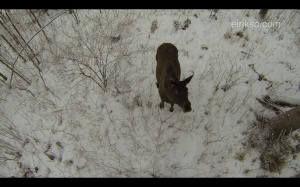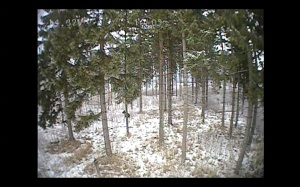First of all. If you want to know what I’m up to next, follow me on twitter: @eirikso
So, I posted this video on YouTube two days ago:
And it have gone completely viral. It was made in a hurry and leaves a lot of things that might need an explanation.
The place and the moose
The video was shot just outside of Oslo. We have a lot of moose roaming around the woods here in Norway. And some of them very close to the city. They’re shy of people, dogs and other living creatures, but are pretty used to the sound of cars, trains, helicopters, planes etc. To see a moose is not very uncommon in Norway.
This moose is probably a 1,5 year old female. She seems more curious than afraid. And we spotted her again from far up in the sky later. Still calmly walking around eating in the same wood.
The technology in general
One of my hobbies for the last year have been to build and fly multirotor helicopters. When I fly them I do it either by flying Line-Of-Sight (LOS) or First Person View (FPV). When flying LOS you simply take off and fly the thing around while watching it from the ground. For quadcopters this limit the range because the copter is symmetric and you loose the orientation pretty fast. However, as I’ve gained experience you start to feel the direction based on speed and the way you control the copter, making it possible to fly further away. I fly LOS when I want to do acrobatics and train accuracy and pilot skills. Here is an example of some acro flying with a very small quadcopter:
KK2 Acro FLights from Eirik Solheim on Vimeo.
But for the video with the moose I fly FPV. Meaning that I have a dedicated camera connected to a video transmitter on board the copter. I feed the video signal into a pair of video goggles and navigate the copter like I was sitting inside it. Based on the video signal. When flying this way I always have spotters beside me that keep an eye on the copter and what is happening on the ground.
In addition to the goggles I have a screen and a digital recorder on the ground station. That recorder also has a mic and records the audio from the spot where we are standing. Ensuring that we got the recording of the quite enthusiastic spotters and my rather nervous comments about battery status and the fact that it is darn difficult to navigate this thing between and under the trees.
The camera
On the copter there is also a GoPro Hero3 to record HD video on board. The video downlink is only SD-quality. In the video I cut to the footage from the DVR at some points to show how it looks from my goggles. Here’s a screen shot from that feed:
You can see the battery status in the top left corner. We spotted the moose at the end of my flight. At 13,2 volts the batteries will be harmed and the copter will descend automatically or simply crash.
Because the HD footage is done in the GoPro on board the copter it was pretty important for us to get it back in one piece. On this copter the GoPro is mounted “naked” without the water proof box. To save weight and make the mounting easier. So I don’t want to crash it in the snow.
The recording in the GoPro is 2,7 K @ 25 FPS. It is slightly stabilised in FCPX and rendered at 1920×1080.
The camera is mounted on a vibration dampened platform under the copter.
The details
The copter I use here is this one.
It is a quad rotor helicopter. Based on a X468 frame that makes it possible to wrap it together for easy travelling. It is controlled by a DJI Naza flight controller that has gyros, accelerometer, barometer and GPS to assist the stabilisation of the copter.
I am using an old Futaba 9C remote with FrSky Tx and Rx modules.
After my previous post about the copter I have changed to three blade, nine inch props (9x5x3). They give me less jello and vibrations in my recordings. In general I find it easier to get rid of vibrations with smaller props running at higher speed. So I run the copter on 4S batteries. Usually two 2200 mAh in parallel. That gives me up to 12 minutes flight time with GoPro and FPV equipment. But 12 minutes is with completely new batteries and when I am pushing the limit. Usually I fly around 8 minutes and land when my batteries are close to 14V. In this video I push it all the way down to 13,2 V when I land.
I have also changed the ESCs on the copter. From Turnigy Plush that I mention in the article about the copter to HobbyKing F30A with SimonK-firmware. That change made the copter way more stable.
Sony RX100
I am also flying this copter with a Sony RX100. It is heavier than the GoPro, giving slightly lower flight time. But the RX100 has excellent image stabilisation built in and you get rid of the GoPro fisheye-look. Here is a RX100-video from the same copter and same area.
The dangers
Multirotors can be dangerous. The props are spinning fast. And they might cut your skin if you get too close when they are running. On my copter I have pretty soft and cheap GWS props. They’re not as dangerous as the carbon reinforced props that many people use. But if you are flying high the pure weight of the copter is dangerous if it falls down. And they do. That is why we are flying outside of the city over fields with no people. And always have spotters on the ground when we fly FPV.
The lipo batteries are very powerful. And can explode or catch fire if they are damaged.
In addition to this there are rules regarding remote controlled devices. They are different in different countries. In Norway you can fly up to 400 feet. And you need a special license to be allowed to put a camera on anything that flies.
If you want to to professional AP work you need an extra license from the civil aviation authority.
The fun and the problem
Lots of people immediately say “I want one” when they see how fun this is. And I can really recommend this hobby. But you need to be patient. First of all it is very difficult to fly these things. It has taken hours and hours of training to be able to fly the way I do in this video.
And even more hours fixing the broken copter after crashing. That is why I build them myself from the ground up. For the first couple of months I never returned with empty batteries. I always returned with a broken copter.
RCgroups is one of the best recourses if you want to start. If you are Norwegian I can recommend our build log over at NRKbeta.no
To start training I can really recommend this small and harmless copter: WLtoys V929. It is a toy, but it is four channel and is controlles just like the bigger copters. If you learn to fly this thing it will be easier to fly bigger and more dangerous copters.



Fy faen til fett. om litt kommer nokk VG til å kontakte dåkke. ditta helikopteret dåkkas er jo helt genialt.
Men kordan styre dåkke den enklig ? har dåkke montert ein skjerm på kontrollen ?
Did you use the gopro for the live stream AND the he recording? What equipment did you use for the live stream?
On this quad I’m using a dedicated camera for the live video feed. I could have used the composite video out on the GoPro, but it gives me more flexibility to use a dedicated camera. Sometimes I fly without recording. Sometimes with a camera that have no video out.
For the video transmitter you have to choose based on the radio you are using, the range you want and the regulations in your country. I use small 5.8 GHz video transmitters.
With these antennas.
I have these goggles
But would consider these as well.
Then you need a simple OSD to get the battery status in the video feed.
RÅTT! 🙂
[…] “The video was shot just outside of Oslo,” Solheim said. […]
I’ve seen too many drone videos. I kept expecting the moose to be blown to bits.
[…] Les om setupen til Eirik på bloggen hans. […]
I am a game warden in the United States. We have a problem with people hunting at night with spot lights. We try to catch them by finding high ground and looking for the sweeping light. Could this technology be used practically for this type of work. I’m thinking the short battery life might be a problem. What are the total costs of this system?
Rob Howe:
Check this one out;
http://www.youtube.com/watch?v=wqlptPhFmk0
Thermal camera, works really good in the dark and you can easly fly it. With a normal camera, its almost impossible to fly when its dark outside because of the image noise and all..
The camera itself is a lil expensive though.. 🙂
awsome, what an experience
Hi,
I have trouble with my 1,2 videolinks and the carbon fibre frames with lots of noise in the video. I read that you use 5,8 and omni antennas. What range do you get and how have you placed the antennas? Straight up? Any antenna extention on the ground such a pole?
[…] har tidligere hatt møter med store dyr her hos NRKbeta. Denne gangen er det ingen droner involvert, men dokumentasjonen er det ingenting […]
[…] Eirikso […]
FANTASTISK film med älgen/moose.
MVH Anders Nilson
https://sv-se.facebook.com/ecksframes
[…] men watching the feed from the GoPro mounted on the quadcopter giggle like schoolkids — and the video that one posts shows what, in a world where every tree seemingly already has a trail cam, may be […]
[…] technology blogger and drone experimenter Eirik Solheim posted a remarkable YouTube video showing a moose in Norway being spotted and approached by a […]
Wow, this is a really cool video. This is probably the safest way to get a good shot of a moose without being mauled.
I would like to use the same setup to trail a heard of Elk that live out here in my neck of the woods. Amazing powerful creatures.
I think it would be a powerful tool to scout various rivers to find where the fish are staking up. Not sure how practical it would be though. Spend all day walking the river of flying a drone? Hmm! I think I’d rather be actually fishing.
Having drones as a hobby needs a lot of focus (and money!). It is an expensive “project” to be in. But it makes it worthwhile in the end especially if you are doing it with like-minded people.
[…] info: https://eirikso.com/2013/01/09/moose-vs-quadcopter/ […]